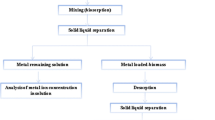Abstract
Microbial biomass provides available ligand groups on which metal ions bind by different mechanisms. Biosorption of these elements from aqueous solutions represents a remediation technology suitable for the treatment of metal-contaminated effluents. The purpose of the present investigation was the assessment of the capability of Brevibacterium sp. cells to remove bivalent ions, when present alone or in pairs, from aqueous solutions, using immobilized polyacrylamide cells of the microorganism in a flow-through system. The biosorption capacity of Brevibacterium cells was studied for lead, cadmium and copper. The metal cell binding capacity followed the order Cu > Pb > Cd, based on estimated qmax. These values, expressed as mmol metal/g dry weight cells, were 0.54 for Cu, 0.36 for Pb and 0.14 for Cd. Polyacrylamide-gel immobilized cells were effective in Pb, Cu and Cd removal. Lead removal was not affected by the presence of Cd and Cu; lead instead inhibited Cd and Cu removal. The desorption of the metal, by fluxing a chelating solution, restored the metal binding capacity of the cells, thus affording the multiple use of the same biomass in the remediation treatment.
Similar content being viewed by others
Author information
Authors and Affiliations
Additional information
Received: 31 July 1997 / Revised: 22 December 1997 / Accepted: 30 December 1997
Rights and permissions
About this article
Cite this article
Vecchio, A., Finoli, C., Di Simine, D. et al. Heavy metal biosorption by bacterial cells. Fresenius J Anal Chem 361, 338–342 (1998). https://doi.org/10.1007/s002160050899
Issue Date:
DOI: https://doi.org/10.1007/s002160050899




